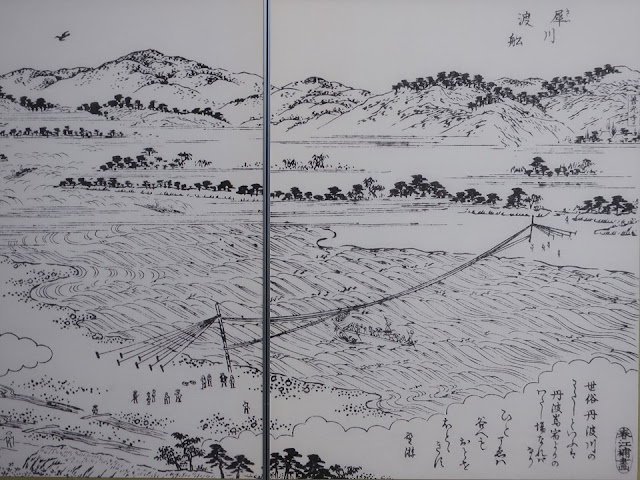History of Nagano City is introduced in
this article. Folklore is introduced in the part 1.
この記事では、長野市の歴史に関する展示を紹介します。なお、民俗はパート1で紹介しています。
Nagano Basin is 50km away from Sea of Japan, HOWEVER, it was sea long time ago. People had suffered from floods.
長野盆地は、なんと元々は海で、水害にも悩まされてきました。
In the Yayoi period (from 4th century B.C. to 3rd century) section, the clay pot with a human face and raising hands (replica, lower left) is very impressive. The actual one was made around 1500 years before. I’d like to know the meaning of the design.
弥生時代の展示では、片山遺跡で発掘された1500年前頃の「挙手人面土器」(左下、複製)。インパクトが強いです。何を願って作ったのでしょうか。
In the ancient period (from 8th to 12th century), Yamato dynasty in Nara prefecture began to rule Nagano. Provincial capital, temple, highways and post towns were built. Current highways were built in the same locations.
古代の信濃。大和朝廷の支配が及び、国府、国分寺、街道、駅ができました。現在の街道の原型ですが、甲州街道はなかったようです。
Zenkouji Temple、善光寺
Zenkouji Temple is the most popular tourist spot in Nagano. Even in the Edo period (1603~1868), many people visited from all over Japan.
The reason for popularity is explained as follows.
(1) Not only men but also women could go into the temple, so many people worship it. (Women were prohibited to go into the temple such as Kouyasan and so on in the old time.)
(2) Minamoto no Yoritomo, who was a powerful military head (shogun), was keen to rebuilt the temple after the fire in 1179. It increased the number of worshippers.
(3) Ieyasu Tokugawa, who was also a shougn, donated large rice field; it became the fund to propagate its religion. The earthquake hit the temple in 1847 while the special event “Gokaicho” was held. Monks from the temple visited even my city, which is around 250km away, in order to ask donation.
(Reference: Yoshino’s daily life 06, from June to August in 1849)
長野市といえば善光寺。関東の人々は東海道で伊勢神宮に行ってお参りし、帰路は中山道から善光寺に行くのが通常のルートでした。
それはさておき、人気の秘密は次のように説明されていました。
② 源頼朝が、1179年に焼失した善光寺の再建に力をいれ、信仰が広まりました。
③ 武田信玄や織田信長などの戦国武将が善光寺如来を他所に移しましたが、1598年、豊臣秀吉が如来を信濃に返しました。この時の移動でも多くの人が知るところとなりました。
参照:Yoshino’s daily life 06, from June to August in 1849(嘉永2年夏)ほか
The picture above shows a legend of Zenkouji. Zenkouji Nyorai helped the female emperor “Kougyoku” (594~661)who fell into hell. It has a great impact. The original picture roll is owned by Zenkouji in Usa city, Ohita prefecture.
善光寺如来絵伝(宇佐市善光寺所蔵品の複製)は、善光寺の創建までを描いた三幅の絵です。第三幅には、地獄に落ちた皇極天皇(女帝、594~661)を善光寺如来が救う場面が描かれています。インパクト強し!鳥居が描かれているのも日本らしいです。
The lively approach to the temple after the earthquake in 1847
門前の賑わい(「地震後世俗話の種」、江戸末期)
The daimyo lord of Nagano city is introduced. Sanada Nobuyuki moved to Matsushiro castle in 1622, then Sanada clan had ruled Nagano city until the end of the Edo period.
1622年に、真田信之が上田から松代城に入り、明治までの250年間、松代藩10万石を治めました。
The ferry of Saigawa (river) was very busy traffic.
江戸時代の犀川の渡船。往来が活発です。
The Hokkoku kaidou which linked Karuizawa and Naoetsu was also busy. Daimyo lords who went to Edo and people who went to Zenkouji temple walked on the highway.
直江津と中山道の軽井沢を結ぶ北国街道は、参勤交代の大名や善光寺参りの人たちが行き来しました。
People put their clothes and belongings in the boxes. It is preserved in a very good condition.
江戸時代の引っ越し道具の挟箱(はさみばこ)。衣服や身の回り物も入れたそうですが、とても良い保存状態です。
The town festivals have been active since the Edo period. The pictures above show the procession of the Matsushiro festival in 1830s. The attractive floats such as a whale are worth seeing. Firework shows are also popular there.
町の祭りは、江戸時代から盛んでした。1830年の松代町の御柱祭りのおねり行列です。鯨など見応えのある屋台です。花火も盛んです。
The famous picture roll (above) was drawn in the late Edo period. It shows the youkai monsters’ parade at night. At the end of the roll, the fire ball (read ball at lower left) calms down youkai.
Some of youkai are Tsukumo-gami which reside in the old utensils; they attack us if we don’t use utensils properly. We can understand what people were afraid of back then. It would lead to “Mottainai policy”. (http://www.greenbeltmovement.org/what-we-do/advocacy/mottainai-campaign)
江戸時代の後半に描かれた「百鬼夜行絵巻」が展示されていました。古い道具に宿るという妖怪・付喪神(つくもがみ)などが描かれ、巻の最後では、火の玉が妖怪を鎮めています。当時の人々が怖れていたことがわかる面白い絵ですね。物を大切にしなさい、というモッタイナイ精神の現れともいわれています。
The Battle of Kawanakajima, which happened at the museum site in the 16th century, is introduced by the folding screen and the video.
川中島の戦いは、屏風とビデオで説明されています。
Battlefield of Kawanakajima、川中島古戦場
Takeda Shingen and Uesugi Kenshin fought five times. In the 4th battle in 1561, Takeda placed his troop headquarters at this place where is the Hachiman shrine now. The death toll was the worst among their battles.
五度の会戦のうち、もっとも死者が多かったという四度目の戦いで、武田信玄が本陣を置いたといわれる八幡社。
It is said that Uesugi on the horse attacked Takeda sitting on the chair in person. Many films and dramas regarding their battles have been produced.
上杉謙信自ら、信玄の本陣を襲い、信玄が軍配で応戦したといわれています。NHK大河ドラマ「天と地と」(1969年)が放映された時に、この有名な像が造られたそうです。八幡社の境内にあります。
Visited
in July, 2021
Official
website: https://www.city.nagano.nagano.jp/museum/ (in Japanese), accessed in March,
2022
Previous
post (Folklore
of Nagano city): Nagano City Museum(1/2)、長野市立博物館(1/2)
Next
post (Preserved house at the beautiful mountain village
in Nagano prefecture): Ozenki residence in Aoni hamlet、青鬼集落・お善鬼の館


















Comments
Post a Comment